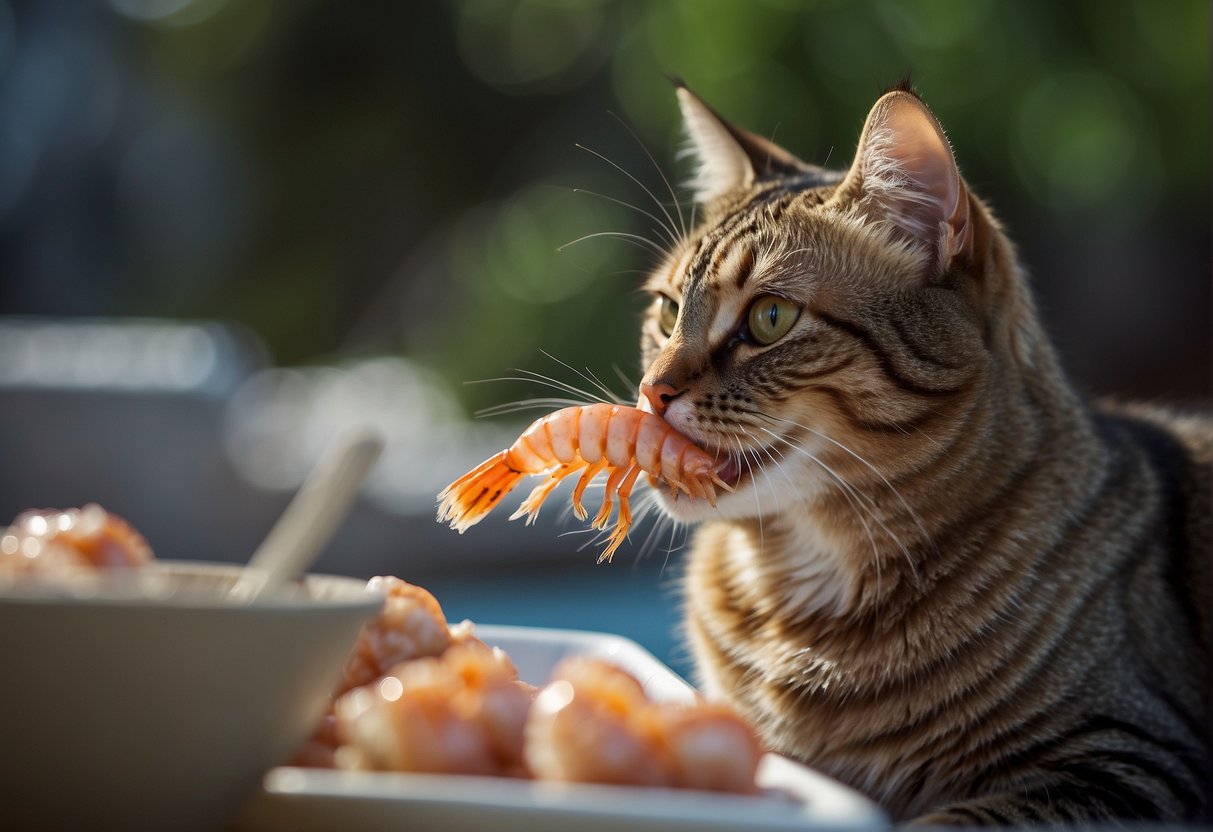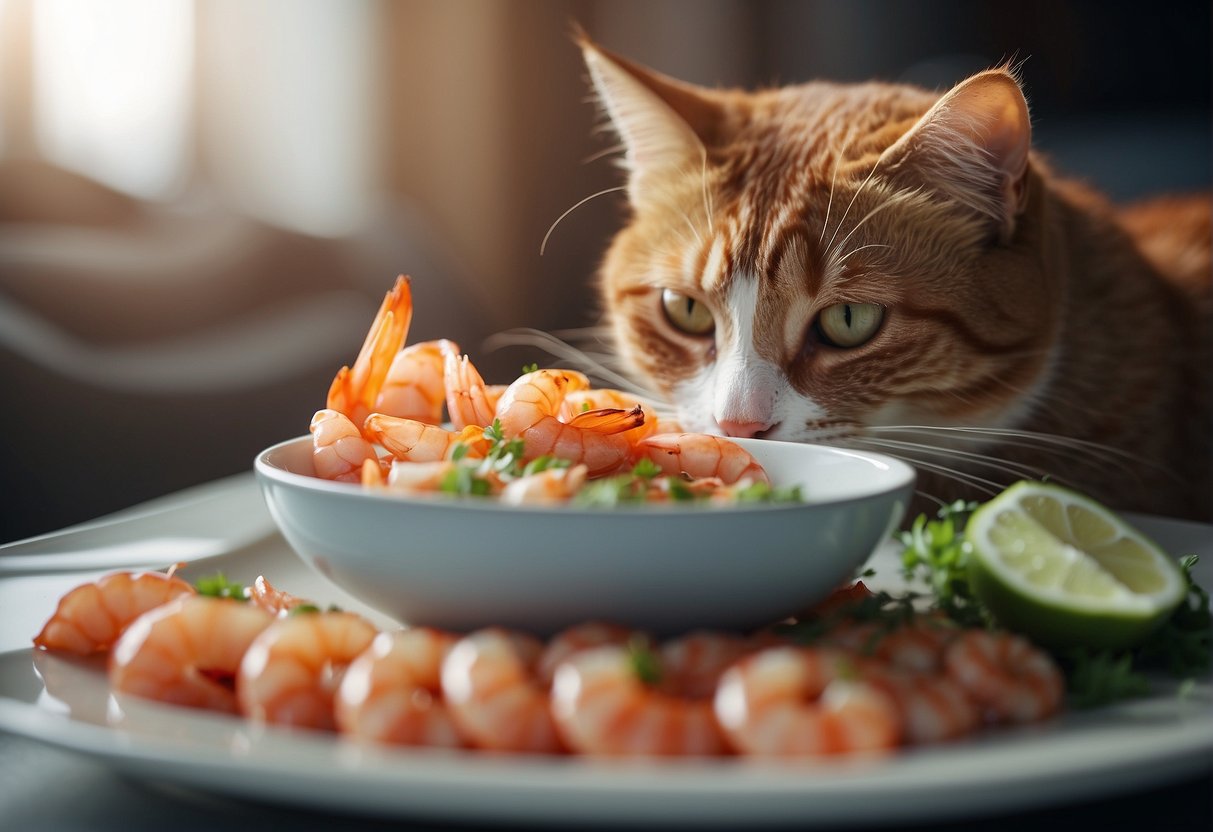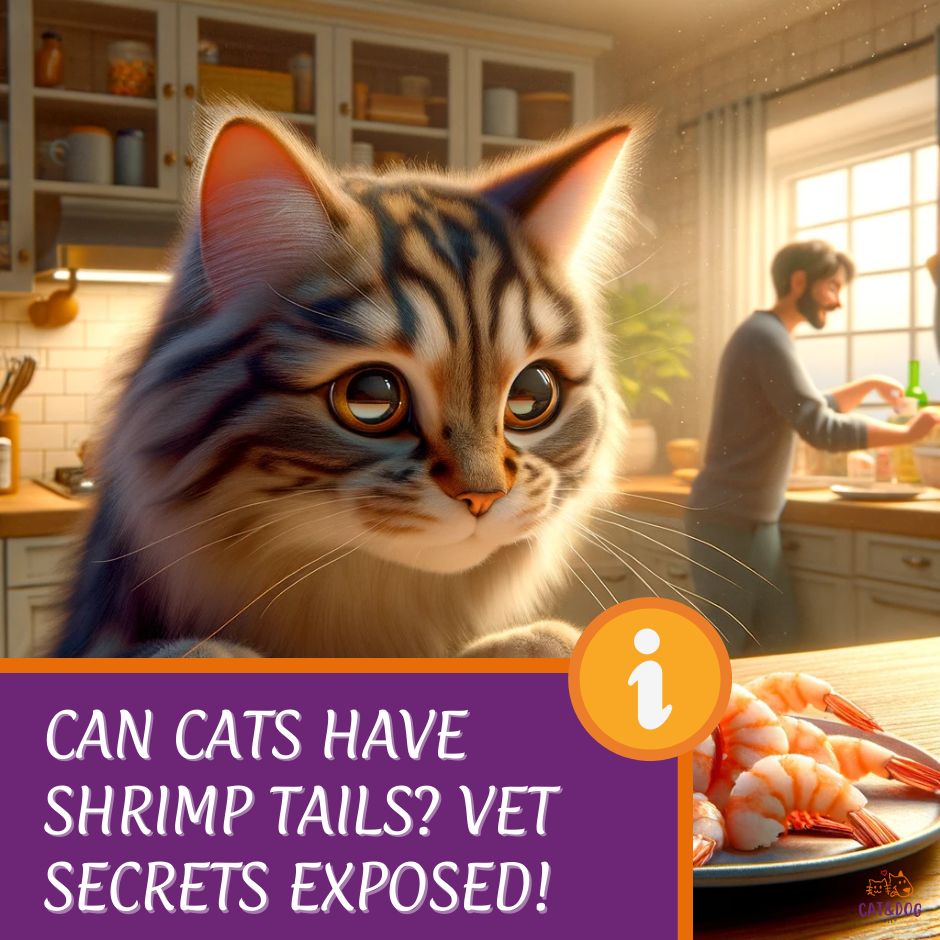As a proud cat owner, you might be curious if can Cats Have Shrimp Tails? Well, let’s dive into the facts.
Cats, as pet owners know, are obligate carnivores, which means their diet should primarily consist of meat.
Given this, it makes sense that shrimp tails might appear on the menu as a protein-rich treat for pet owners.
However, before you start sprinkling cooking shrimp tails into your cat’s dish, it’s essential to consider both the benefits and the risks.
While shrimp tails do contain protein, they also present potential hazards such as choking or causing digestive blockages.
Additionally, shrimp tails may contain harmful bacteria and parasites, such as Vibrio and Listeria, that can cause cat food poisoning.
Cooking the shrimp tails thoroughly can reduce the risk of contamination, but feeding them to cats is still not recommended.
It’s no surprise that these crunchy crustacean ends have gained popularity as a pet treat—but should they make a regular appearance in your cat’s diet?
Key Takeaways
- Cats can eat shrimp tails, but caution is advised, it’s better to avoid potentially harmful food for cat.
- Shrimp tails offer protein but also pose risks like choking.
- Consult a vet before feeding your cat shrimp tails.
Nutritional Benefits of Shrimp Tails for Cats

Have you ever wondered if those shrimp tails you often discard could be a tasty treat for your furry friend?
Well, you might be onto something!
Shrimp tails are more than just a crunchy snack; they pack a punch with some essential nutrients beneficial for your cat. (1)
High Protein Content
First up, let’s talk about protein. Cats are natural hunters and, as such, rely heavily on a diet rich in animal protein. (2)
It’s crucial for everything from muscle development to immune health. A cat’s diet typically requires about 26% protein, which shrimp tails can contribute to.
These crunchy bits are a valuable source of protein, helping your kitty maintain those strong muscles for all their pouncing and leaping.
Omega-3 Fatty Acids
But what about shiny coats and healthy skin?
Omega-3 fatty acids, often found in seafood, are your cat’s best friend for maintaining that glossy sheen. Here’s what the experts say:
“Regular intake of omega-3 fatty acids can lead to noticeable improvements in a cat’s skin and coat health, reducing inflammatory responses and contributing to overall well-being.”
This means those shrimp tails might assist in keeping your cat’s coat looking vibrant and feeling smooth. (3)
Taurine for Heart Health
Now, let’s get to the heart of the matter – quite literally! Shrimp tails contain taurine, an amino acid that’s vital for heart health in cats. (4)
Studies have shown that a taurine deficiency in cats can lead to serious heart issues like cardiomyopathy.
But don’t worry, incorporating foods rich in taurine, such as shrimp tails, into your cat’s diet can support healthy cardiac function.
So, there you have it! Shrimp tails aren’t just leftovers; they’re a source of protein, fatty acids for a sleek coat, and taurine for a strong heart.
Just remember to serve them in moderation and ensure they’re properly cleaned and cooked to avoid any health risks. Your kitty will surely purr in appreciation!
Potential Risks and Health Warnings

Allergic Reactions and Sensitivities Have you ever wondered if your furry friend could have an allergy to something as simple as seafood? (5)
Just like humans, cats can develop food allergies and sensitivities. If your cat starts showing symptoms like itchy skin, sneezing, or digestive upset after munching on shrimp tails, these could be telltale signs of an allergic reaction.
In fact, it is documented that about 1-3% of cats suffer from food allergies.
Risk of Intestinal Blockage Curious how those seemingly harmless shrimp tails could pose a danger?
Well, they’re not easily digestible and can lead to an intestinal blockage in the digestive tract.
This isn’t just an old cat’s tale; veterinarians often warn that consumption of hard-to-digest substances like shrimp tails could result in your kitty experiencing abdominal pain, lethargy, and it might even need surgical intervention based on clinical cases.
The sharp edges of the shrimp tail can cause cuts or blockages in the digestive tract, which can be fatal if left untreated.
Mercury Toxicity and Parasites
Ever fretted about what’s lurking in your cat’s seafood?
- Mercury: A sneaky guest that can accumulate in seafood, including shrimp.
- Parasites: Unwelcome visitors that can hitch a ride within raw seafood.
Proper cooking can help avoid these, but it’s always better to be safe than sorry when it comes to your cat’s dinner!
Bacterial Contamination
Sushi night? Not so fast! Raw seafood can harbor bacteria like Salmonella or Listeria, which are no joke for your kitty’s health. (6)
Studies suggest these can cause serious illness in cats. Always ensure shrimp tails are well-cooked and properly stored to avoid such risks.
Hey, you want what’s best for your whiskered companion, don’t you? Keep these pointers in mind, and you’ll navigate the waters of feline nutrition safely!
Safe Feeding Practices for Shrimp Tails

Ever wondered how to treat your feline friend to some tasty shrimp tails without causing them harm? Here’s how you can do that safely!
Appropriate Portions and Frequency
Hey, moderation is key! Don’t go overboard with portions; a small piece of a shrimp tail is enough for a taste test, especially for a start.
- Small Cats: Begin with a tiny piece once a week.
- Large Cats: Can handle a little more, but keep it sparse.
- Senior or Health Issues: Consult your vet first.
Remember, shrimp tails are a treat, not a meal replacement.
Preparation Techniques
I know it’s tempting to just hand over a shrimp tail, but let’s get those tails ready for a safe nibble.
- Clean Properly: Ensure the shrimp is fresh and thoroughly cleaned.
- Remove Sharp Edges: Snip off any pointy parts that could be hazardous.
- Cook Them Right: Either steam or boil them; raw is a no-go due to potential bacteria.
Monitoring Your Cat’s Reaction
Watch out for signs of enjoyment or distress. A happy dance is good; digestive upsets, not so much.
- Observe after feeding — any unusual behavior? Tummy trouble?
- Maintain a watchful eye for allergies or choking.
- When in doubt, stop the shrimp tails and consult your vet.
Remember, stay informed and vigilant. Happy and safe snacking!
In-Depth Veterinary Insights

Hey there, you’ve probably wondered whether those shrimp tails from your dinner are safe for your purring friend.
Let’s dive into what the experts say and give you the scoop on shrimp tails as a feline snack.
Nutritional Analysis of Shrimp Tails
While not as meaty as the rest of the shrimp, the tails do contain:
- Protein: Cats need plenty of it, and shrimp tails can offer a boost.
- Omega-3 fatty acids: Great for coat health and joint mobility.
- Chitin: This is found in the shell; it’s hard to digest, but sometimes mentioned for fiber.
When you compare this to your cat’s regular chow, remember that commercial cat foods are specifically formulated to meet all of their needs, making them a more balanced option.
Expert Opinions and Case Studies
“I occasionally give shrimp, including the tails, to cats with no adverse effects, as long as it’s in moderation,” says Dr. Whiskerpaws, a renowned veterinarian.
Recent studies also suggest moderate amounts may be beneficial. However, individual cat tolerances vary.
Now, remember, treat these tails as an occasional delicacy; they’re not a substitute for a complete diet. And always check for any allergic reactions, especially if it’s their first shrimp rodeo.
If you’re ever in doubt, your vet’s advice is just a quick call away – they’re the real cat whisperers, after all.
Keep your feline’s tail wagging with the right balance and a sprinkle of culinary adventure.
Balanced Nutritional Approach

Have you ever glanced at your cat’s dinner and considered adding a bit of variety?
Cats need a steady and balanced diet, but like us, they might appreciate a little change now and then.
Shrimp tails are on the table, but they should not be a main course.
They pack a punch with protein and omega-3 fatty acids, good for muscle development and a shiny coat, but they are like the dessert of the cat world: fine in moderation and with health benefits.
Now, you might wonder, what’s a safer bet when looking to treat your whiskered friend? Let’s take a peek at some safe seafood alternatives:
- Cooked shrimp (minus the tail)
- Boned salmon
- Deboned whitefish
Each of these options still provides high-quality protein and essential fatty acids without the choking risk or potential digestive issues that shrimp tails might pose.
Not a fan of seafood? No problem! Here are some non-seafood treats that are safe and healthy:
- Cooked, lean chicken or turkey (no bones or skin)
- Small amounts of cooked beef
- Scrambled or boiled eggs (a nice source of protein)
Remember to compare nutrition! Unlike shrimp tails, these alternative treats offer benefits with less risk.
They’re like the trusty old friends who never let you down, versus the flashy new ones who might cause a stir.
By incorporating these alternatives into your cat’s diet, you’ll be effectively diversifying their meals without sacrificing nutritional value.
Keep it bite-sized and infrequent to complement their commercial cat food. What’s better than a happy and healthy cat purring at mealtime, right?
Quick Recap

Ever wondered if you can treat your feline friend to those shrimp tails you usually toss away? Let’s break it down:
- Carnivore’s Delight:
Cats are meat lovers, and seafood, like shrimp, is high in protein which cats need. - Tails, Beware:
Shrimp tails themselves are not toxic, but they’re tough and can be hard for your cat to digest.
Digestive Distress:
Should your whiskered buddy nibble on a tail, watch out for:
- Vomiting
- Diarrhea
- Loss of appetite
Health Hazards:
Shrimp tails might lead to:
- Choking hazards
- Gastrointestinal blockage
- Abdominal pain
Responsibility First:
Remember, although it’s tempting to share, it’s crucial to prioritize your cat’s health with suitable treats. Not all human food is safe for pets, right?
Here’s a quick tip! Opt for shrimp meat over tails, as it’s softer and easier for your cat to enjoy without the risks.
If you decide to indulge your cat’s shrimp craving, do it sparingly and make sure that shrimp becomes more of a rare delicacy than a staple—balance is key! Remember to remove the shrimp shells and tails before feeding them to your cat, as they may be hard for cats to digest.
Remember, you’re the gatekeeper of your cat’s diet, so ensuring their meals are safe is your superpower. If in doubt, a quick vet chat won’t hurt.
Keep this tail tale in mind next time you’re peeling shrimp, and your kitty gives you the big eyes!
Frequently Asked Questions

You’ve got questions, we’ve got answers!
When it comes to your feline friends chowing down on shrimp tails, there’s a lot to consider. Let’s jump into the meat of the matter and nibble on the specifics.
Can cats safely eat shrimp tails?
Absolutely, cats can eat shrimp tails, but caution is key.
Just like with any treat, moderation is essential, and you should always keep an eye on your cat while they enjoy their snack to prevent any choking hazards.
What are the nutritional benefits of shrimp tails for cats?
Shrimp tails are packed with protein and can be a source of taurine, an essential amino acid that’s vital for your cat’s heart and eye health.
Remember though, they are only a treat and should not replace a balanced diet.
Are there any risks associated with feeding shrimp tails to cats?
There are a few concerns to be mindful of. Shrimp tails might be a choking risk, and some cats may have digestive issues after eating them.
It’s always best to consult with your vet first.
How should shrimp tails be prepared for cats?
Cooked and unseasoned is the way to go! Avoid any added spices or oils that can be harmful to your cat.
Plain, boiled shrimp tails, cooled down and served in small pieces, are safest.
Can shrimp tails cause allergic reactions in cats?
While it’s uncommon, cats can develop allergies to shellfish, including shrimp tails.
If you notice any odd symptoms, like itching or gastrointestinal upset, it’s time for a vet visit.
What portion size of shrimp tails is safe for cats?
Tiny portions are best. A shrimp tail or two is plenty as an occasional treat.
Remember, treats should make up no more than 10% of your cat’s daily calorie intake.
- Advantages of Playing Casino Online - July 6, 2025
- How players can take advantage of the no deposit bonus at the Casino - July 5, 2025


